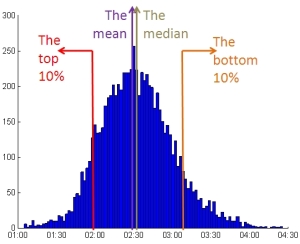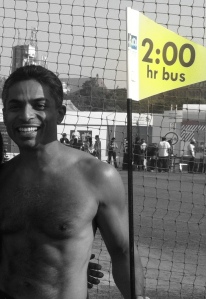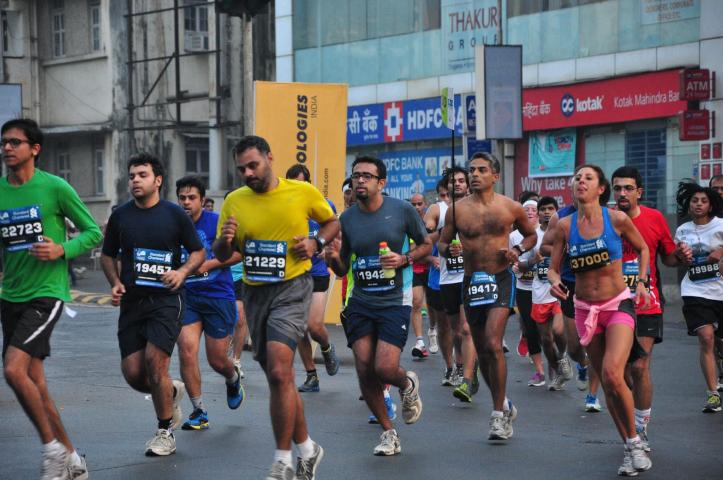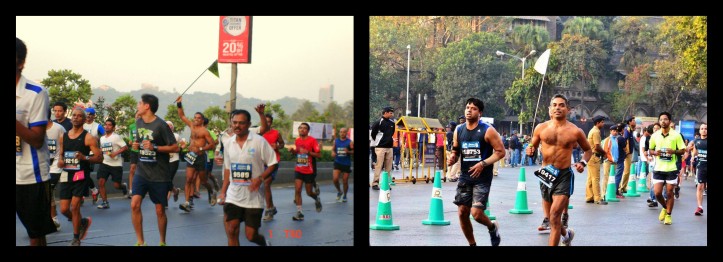
In India, the number of distance running races open to the general public has been increasing each year. Since the first ever such race, the Mumbai Marathon in 2004, there is now a race or often multiple races during just about any given weekend in this vast country. A useful feature of an increasing number of these races is a pacer for various finish times. A pacer is an experienced runner who is meant to take those who started at the same time as the pacer, across the finish line within the time previously declared for that pacer. Popular times in India for the full marathon have been 4, 4:30, 5, 5:30 hours for the full marathon and 2, 2:15, 2:30, 2:45 and even 3:00 hours for a half marathon.
Despite race times being important for those who join a pace group, the number of pacers who have been failing to do their job in Indian races is annoying, irritating and defeats the purpose for which the facility exists. This article has my tips for you, whether you are:
(i) a race organizer
(ii) a wannabe pacer
(iii) a pacer
(iv) a race runner choosing a pacer to stay with.
If you are a race organizer and looking for a pacer, here are some pointers:

- having pacers makes your race look better organized and, perhaps, helps justify the race entry fee, so be rest assured that they are a good idea
- but, like the rest of your race, proper planning for perfect execution leaves less to chance
- so, do a thorough check on pacers for your race
- which should include not just the headline number for their PB but also details of when that was, in which race and whether the person is free of injury (a PB of 1:50 in the Delhi half marathon does not make the candidate suitable to be a 2:00 pacer in Mumbai)
- remember, “he’s a fast runner” does not translate into “he’ll be a good pacer”
- check that the person has race times that are consistent across races allowing for race conditions (a 1:50 PB in Delhi followed by 1:45 in Goa just 3 weeks later suggests you have a runner who is likely to be inconsistent)
- check consistency within races (very different race splits between the first/second half for a reasonably flat course e.g. Mumbai suggests this person may fail as a pacer)
- pacing requires discipline to go noticeably slower than you can – sounds easy in theory – but check with other runners if the person who would like to be a pacer is capable of doing this
- pacers need to be visible in a crowd – all else being equal, pick the taller runner
- it is not mandatory to be a chatty pacer but, all else being equal, pick the runner who has a louder voice and a commanding yet caring tone
 Remember, if the pacer fails to do his or her job, the reputation of the race organizer is at risk. Once a pacer fails to do the job properly (more than 2 minutes faster than target time or slower than 45 seconds faster than target time) they should not be given a chance to pace again in a public race. This translates, for example, to a window of 1:58-1:59:15 finishing time for a 2:00 hour pacer.
Remember, if the pacer fails to do his or her job, the reputation of the race organizer is at risk. Once a pacer fails to do the job properly (more than 2 minutes faster than target time or slower than 45 seconds faster than target time) they should not be given a chance to pace again in a public race. This translates, for example, to a window of 1:58-1:59:15 finishing time for a 2:00 hour pacer.

Finally, remember, (as was clear in a previous blog) the distribution of finishing times follows an approximate bell curve. Therefore, it makes sense to distribute your race pacers accordingly. For instance, 3 pacers each for 2:00, 2:30 and 3:00 is not consistent with the needs of the runners in the Standard Chartered Mumbai (half) Marathon. Instead distribute the pacers across the time span with a similar distribution profile.


The friends I have recommended as pacers have done an excellent job so far. In return for perfect execution they have received priceless gratitude from race participants who have run successfully in their cohort. The satisfaction from a task well done is immense. The feedback from other runners multiplies that!
I heard a report recently of a 2:15 pacer who boasted that he finished in 2:04. I hope no race organizer will ever give this person a second chance to be a pacer.
Here are some reasons that you should not choose to be a pacer:
- you are simply bored of first running half marathons, then full marathons and then ultra marathons and now want to “try something new”
- you have never actually paced someone successfully for the same distance and similar time on that or a similar course before
- you find it difficult to achieve targets in other areas of your life
- you routinely arrive at meetings or rendezvous points 1 or 2 minutes late
- you are looking to show off that you were a pacer for a race
If you are unsure about your ability to be a pacer, err on the side of caution and do not volunteer to be a pacer. Instead, be an unofficial pacer and take a group of friends who are running that race and pace them. Once you are confident that you are able to execute the job of a disciplined pacer, then volunteer the following year or for an earlier similar race.
You have been chosen as a pacer. Hopefully you have been chosen for the right reasons. As a pacer, you need to strike a balance between being both ruthless and compassionate in your execution. This means bringing as many runners as possible across the finish line before the advertised time. So:
- make your pacing strategy clear to all the runners
- e.g. if you plan to pace to negative splits (a faster second half)
- e.g. where you plan to walk (for instance at hydration points or infamous steep hills)
- it is advisable that you describe your strategy in words in addition to sharing any numerical information (that some new non-technical runners may not be familiar with)
- for runners who are far behind your specific starting enclosure suggest a catch-up plan that will work without risking their overall time; remember, they do not actually need to catch-up!
- make yourself appear as someone who can do the job
- make yourself as visible as possible on race morning (arriving just 10 minutes before the start and waiting in the wrong enclosure is not the way to go)
- answer truthfully and with confidence any questions that may be thrown at you before the starting gun goes; someone with a PB of 2:19 in a similar race 2 months ago is unlikely to benefit from being on your 2:00 bus! Suggest that they try to locate the 2:15 pacer!
- once the race starts, if you had planned for a slower start through the crowds, do not panic when you actually do see that it’s not easy to move your cohort through the crowds – instead do reassure them that it will not be a problem
- continue to make yourself visible during the race – remember, there are people who are in your cohort but you don’t know it – they may be up to 200m behind you!
- although the run is an easy one for you, it won’t be for the others with you. It is also not your job to entertain them. However, if you find a nice balance between allowing them to focus on their running, while also encouraging them with useful commentary and positive feedback while running that would help. An example of a supportive and informative announcement might be “we are bang on target, there’s a water station coming up in 4 minutes, you will have an opportunity to walk for a few seconds while the bus slows down considerably for 20 seconds”
- when you know you are approaching a water station that you planned to slow down at, encourage runners to help each other pick up drinks and make way for those who need to reach the water station volunteers
- if there are only small plastic bottles of water being handed out, encourage runners to not just take one sip and throw the bottle – remind them about the need to keep our planet healthy too and encourage them to carry the bottle if they will need to drink again (before they eventually chuck the plastic away)
- if you find someone sticking too close to you, request them politely to give you space – this personal space will be particularly useful for a runner with a problem mid-run to approach you if they have a question that pertains specifically to them e.g. “there’s 5km to go and I can feel some pain in my knee, what do I do?”
- once you reach what I like to call “the best effort segment” towards the end of the race (e.g. after crossing Pedder Road with about 6.5km to go in the Standard Chartered Mumbai Marathon) tell your runners that they could gradually start to increase their pace if they feel strong enough to and that they will do even better than their hoped for target if they keep getting further ahead of you
- however, remind them that if they stay with you they will still achieve their goal
- the last few kilometers are always the toughest for those running with you; this is when your motivational skills are required the most – use them!
- do not be tempted to slow down for any runner who is not able to keep up, no matter how friendly and dedicated he seems, or how pretty she looks! Be encouraging, but be ruthless in your execution!
If for some unfortunate reason you do not manage to finish within the window prescribed, be fair and apologize to the organizers and runners! And, if you are too fast, for heaven’s sake, do not gloat that you finished 10 minutes and 8 seconds ahead of your target – it might just be your last run ever! Do the world and yourself a favour and do not offer to be a pacer ever again!
When you are depending on a pacer to achieve your race target, your choice of pacer is very important.
- pick a pacer group with a target finishing time that is appropriate for your race goal which should itself be consistent with your training while allowing for a small premium for race day speed
- if the pacer is someone you know, there’s not much to worry about, you are probably justified in having full faith that, with the right training beforehand, you will achieve your target
- when you do not know any of the pacers do read their public profiles and try to understand if they are the right pacer for you based on all that I have said above to the organizers, wannabe pacers and actual pacers
A pacer in a race is a disciplined guide within an event which has performance pressure. Guidance in anything is extremely useful when navigating uncharted waters. Whether it is about being a pacer, choosing one as a race organizer or for your race personal best, make decisions intelligently and dispassionately.
Dr Purnendu Nath spends his waking hours focusing on helping individuals and organizations reach their goals, to make the world a better place. He speaks, writes and advises on topics such as finance, investment management, discipline, education, self-improvement, exercise, nutrition, health and fitness, leadership and parenting.






good and interesting article.. would love to pace just to enjoy the experience and give back to running… but like you said, would probably un-officially pace a few races to see if I enjoy it and see if its up my alley…
LikeLike
[…] to focus on various aspects of your running – breathing, gait, cadence, hydration etc. In my previous blog on pacing I spoke about making decisions intelligently whether you are a pacer, a race organizer or […]
LikeLike
Hi puru.. Started my pacing journey this year and frankly I was introduced to your pacing strategies through one of my running colleagues. Very convincing and was able to do it comfortably for a 2 hr bus where I was almost on dot. Wanted to share with you my stats and wanted to connect for the same. Is it possible to get in touch
LikeLike
Hi Krishna!
Nice to hear from you…
I’d be happy to hear the details, including any numbers that you are able to share.
It would be best to email me at PuruTheGuru@gmail.com
Cheers!
Puru
LikeLike
An informative article packed with practical insights….
However don’t be in a hurry to write off and condemn a failed pacer. Finishing much ahead is a crime and it is great to finish about a minute before the target time but in many races some pacers have finished slightly behind the target time 1 to 2 mins without bringing the art pacing into disrepute. While no pacer ever wants to end slower than target time but in the ultimate analysis we all are humans and there can be many circumstances beyond control. I know of many pacers who are still star pacers despite finishing 1-2 mins behind the clock.
Similarly in the AHM 2014 I saw that some pacers failed to complete the race at all due to race day conditiona yet those too were great runners but some times things can just be out of control for no good reason. It’s a sport and an art not an exact science like fluid dynamics.
Ultimately it is more important how many of the bus passengers who followed the pacer were able to complete their own run within the bus time.
Cheers and happy pacing whether you are a pace setter or a follower..
LikeLike
Dear Virender
Thanks for your comments.
Other than the odd smart-arse (I heard of one at the ADHM-2014) who becomes a pacer, most who do it, do it for the joy of giving back.
However, failure to do a job, is just that… failure!
Whether it is pardonable or not depends on how it happens. The unexpected injury in the late stages of a full marathon or ultramarathon are excusable.
Poor weather, slow racers on the bus, losing track of time/distance, these are not excusable – especially for a half marathon. And it is for that reason that I would not pace a 1:45 bus despite a 1:38 PB. Possible failure on my part must not impact other racers who depended on me.
I’m sure those who fail to achieve their pace setter targets are not bad people. But, we should just accept that they failed at that job.
Wilful blindness in society is endemic, let’s weed it out in every place possible.
Have a fantastic 2015!
Regards
Puru
LikeLike
[…] a previous blog on pacing I spoke about making decisions intelligently whether you are a pacer, a race organizer or […]
LikeLike
[…] 3 articles I wrote prior to this one were also on pacing: (i) a Pacer Guide (for the race organizer, wannabe pacer, race pacer, or the race runner) (ii) my pacing strategy for […]
LikeLike
[…] writing a few articles (1, 2, 3 and 4) on marathon race pacing prior to last month’s Standard Chartered Mumbai Marathon […]
LikeLike
[…] advise you, whether pacer, race organizer, wannabe pacer or race runner to also read my article on the matter of pacing to better understand how to make the most of this useful facility that is now a part of most public […]
LikeLike
[…] a previous article I had advised that pacers ought to be placed at frequent intervals with the same profile as the […]
LikeLike
[…] running with a pacer at SCMM-2016, then it will be worth your while to also read about that in my guide to pacing and choosing pacers. Let us also hope that there is greater success among the pacers themselves and lessons have been […]
LikeLike
[…] Pacers I spoke to you earlier about the benefits of, and how to choose a pacer. Having said that, I also checked with you via an earlier poll regarding last year’s SCMM (2015) […]
LikeLike
[…] I have many friends among both the lists above and I hope that those who didn’t finish successfully will not take this report personally. I am sure they already feel quite rotten about what transpired. Perhaps they will step back and think about their performance objectively. In the cases where the same pacer has failed two years in a row, perhaps we should ask the race organizers “why was that person selected in the first place?” Also, given that many accomplished fast runners with impeccable race pacing histories were not selected as pacers, what happened to the selection process this year? Why were fast race targets given to pacers whose personal bests were on flat routes and cold weathers and within seconds of their pacing target in hot, humid, non-flat Mumbai? Did they not understand what I said in my well-read guide to pacing? […]
LikeLike
[…] may remember my blog about being a pacer followed by one report after another about pacing failures by others in the Mumbai Marathon for […]
LikeLike
[…] with just about everything in life, (see examples regarding nutrition, discipline, fitness) I like to think about the dimension of time when it comes to pain too. Sometimes pain stays with […]
LikeLike
[…] you are also mindful that the details matter in driving results – be it in food and drink, exercise or rest. But that does not make you a freak! You are doing what is naturally good. You are […]
LikeLike
[…] Pacers I spoke to you earlier about the benefits of, and how to choose a pacer. Having said that, I also checked with you via an earlier poll regarding last year’s SCMM (2015) […]
LikeLike
[…] Failures at the SCMM 2015 a year prior to that. For some background, my most widely read guide on being a pacer or choosing a pacer is worth going through if you haven’t […]
LikeLike
[…] or someone who is selecting a pacer for help in their next race, you would be well advised to read my guide on […]
LikeLike
[…] Messenger is Back Ever since my “Being a Pacer, Choosing a Pacer – A Guide” I have published a table once a year after the Standard Chartered Mumbai Marathon (SCMM) on the […]
LikeLike
[…] Messenger is Back Ever since my “Being a Pacer, Choosing a Pacer – A Guide” I have published a table once a year after the Mumbai Marathon on the performance of official […]
LikeLike
[…] Messenger is Back from Delhi Ever since my “Being a Pacer, Choosing a Pacer – A Guide” I have published a table once a year after the Mumbai Marathon on the performance of official […]
LikeLike
[…] since my “Being a Pacer, Choosing a Pacer – A Guide” I have published a table once a year after the Mumbai Marathon on the performance of official […]
LikeLike
[…] since my “Being a Pacer, Choosing a Pacer – A Guide” I have published a table once a year after the Mumbai Marathon on the performance of official […]
LikeLike